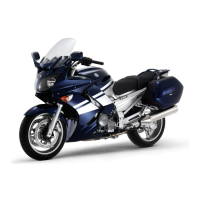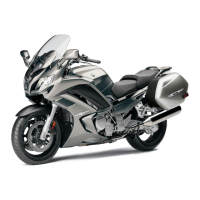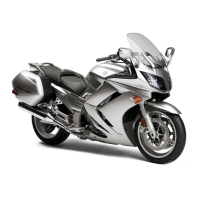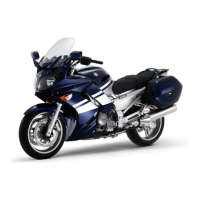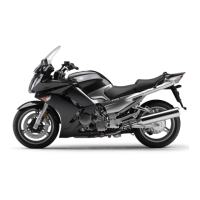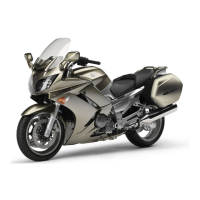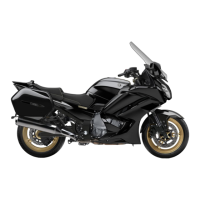Do you have a question about the Yamaha FJR1300AE and is the answer not in the manual?
Detailed explanation of labels 1 through 6 for vehicle identification and safety.
Detailed explanation of labels 7, 8, and 9 for notices and tire information.
Outlines the owner's responsibilities for safe motorcycle operation and training.
Provides guidelines for visibility, intersection safety, and avoiding blind spots.
Emphasizes the importance of helmets, face shields, and protective clothing.
Warns about the dangers of carbon monoxide from exhaust fumes.
Advises on distributing weight and maximum load limits for safe handling.
Discusses the benefits and availability of genuine Yamaha accessories.
Provides instructions and precautions for safely transporting the motorcycle.
Identifies key components visible from the left side of the motorcycle.
Identifies key components visible from the right side of the motorcycle.
Details the location and numbering of all controls and instruments on the handlebars.
Explains the functions of the main switch and how to lock the steering.
Identifies and explains the function of various indicator and warning lights on the dashboard.
Describes the oil level warning light and its implications for engine health.
Details how to activate, set, adjust, and deactivate the cruise control system.
Introduces the meter unit and its various displays and functions.
Explains the speedometer for speed and tachometer for engine RPM.
Describes the fuel level display and the eco indicator for fuel-efficient riding.
Details how to access and adjust various functions via the display.
Explains how to switch between different information displays on the meter unit.
Describes how to read ambient temperature and engine coolant temperature.
Explains average and instantaneous fuel consumption displays.
Covers windshield adjustment and entering the main setting mode.
Details the function of switches on both left and right handlebars.
Explains how to use the hydraulic clutch lever and adjust its position.
Describes the operation of the shift pedal and front brake lever.
Explains the unified brake system and the Anti-lock Brake System (ABS).
Details the function and engagement of the traction control system.
Instructions on opening/closing the fuel cap and safe refueling procedures.
Covers removing/installing seats and adjusting rider seat height.
Information on storage locations and the accessory box for carrying items.
Guidance on adjusting headlight height for visibility and compliance.
Covers folding mirrors and adjusting front/rear suspension preload.
Instructions for using the 12V accessory power outlet safely.
Explains the sidestand operation and the safety system preventing engine starts.
Describes how the cornering lights illuminate the road during turns.
Ensures sufficient fuel, checks for fuel line leaks, and hose integrity.
Verifies engine oil level and checks for oil leakage in the final gear case.
Checks coolant level and inspects the cooling system for leaks.
Verifies brake operation, fluid levels, pad wear, and hydraulic system integrity.
Checks clutch operation, fluid level, and hydraulic system for leaks.
Ensures smooth operation, checks free play, and lubricates cables as needed.
Inspects tires for damage, tread depth, air pressure, and checks wheel condition.
Verifies the ignition cut-off system linked to the sidestand is functioning correctly.
Explains the inertial measurement unit and auto-stop features for engine safety.
Step-by-step guide for starting the engine, including pre-start checks and conditions.
Details how to shift gears for acceleration, including recommended shift points.
Explains how to decelerate smoothly and downshift gears appropriately.
Provides crucial instructions for the initial break-in period to ensure engine longevity.
Safe practices for parking the motorcycle, considering hot components and stability.
Identifies the included tool kit and its intended use for basic maintenance.
Outlines required maintenance for emission control components at various intervals.
Provides a comprehensive schedule for general maintenance and lubrication tasks.
Guides on how to safely remove and reinstall body panels for maintenance access.
Details the process for checking spark plug condition and gap for engine performance.
Instructions for checking engine oil level and changing oil and filter.
Procedures for checking and changing the final gear oil to ensure drivetrain lubrication.
Explains how to check coolant level and the process for changing coolant.
Steps for cleaning or replacing the air filter to maintain engine air intake quality.
Procedure for checking and adjusting the engine's idling speed for optimal performance.
How to measure and adjust throttle grip free play for responsive throttle control.
Importance of checking and adjusting valve clearance for engine health.
Critical checks for tire condition, tread depth, and proper air pressure.
How to inspect brake pads for wear and ensure braking performance.
Verifying fluid levels in brake and clutch reservoirs for proper system function.
Guide on identifying and replacing blown fuses to restore electrical circuits.
General guidance and procedures for diagnosing common vehicle issues.
Diagnostic charts to identify and resolve issues related to starting or poor engine performance.
Steps to diagnose and address engine overheating issues, including coolant checks.
Specific advice on cleaning and caring for matte finish parts to prevent damage.
Recommended procedures for washing and cleaning the motorcycle to maintain appearance and function.
Steps to prepare the motorcycle for extended storage to prevent damage and corrosion.
Location and importance of vehicle ID, engine serial, and key identification numbers.
Identifies locations of model and emission control labels for reference.
Explains vehicle data collection by the ECU and Yamaha's privacy policy.
Procedures for reporting safety defects to authorities and Yamaha Motor Corporation.
Details the terms, conditions, and exclusions of the manufacturer's limited warranty.
Information on purchasing extended service plans for added coverage.
Detailed explanation of labels 1 through 6 for vehicle identification and safety.
Detailed explanation of labels 7, 8, and 9 for notices and tire information.
Outlines the owner's responsibilities for safe motorcycle operation and training.
Provides guidelines for visibility, intersection safety, and avoiding blind spots.
Emphasizes the importance of helmets, face shields, and protective clothing.
Warns about the dangers of carbon monoxide from exhaust fumes.
Advises on distributing weight and maximum load limits for safe handling.
Discusses the benefits and availability of genuine Yamaha accessories.
Provides instructions and precautions for safely transporting the motorcycle.
Identifies key components visible from the left side of the motorcycle.
Identifies key components visible from the right side of the motorcycle.
Details the location and numbering of all controls and instruments on the handlebars.
Explains the functions of the main switch and how to lock the steering.
Identifies and explains the function of various indicator and warning lights on the dashboard.
Describes the oil level warning light and its implications for engine health.
Details how to activate, set, adjust, and deactivate the cruise control system.
Introduces the meter unit and its various displays and functions.
Explains the speedometer for speed and tachometer for engine RPM.
Describes the fuel level display and the eco indicator for fuel-efficient riding.
Details how to access and adjust various functions via the display.
Explains how to switch between different information displays on the meter unit.
Describes how to read ambient temperature and engine coolant temperature.
Explains average and instantaneous fuel consumption displays.
Covers windshield adjustment and entering the main setting mode.
Details the function of switches on both left and right handlebars.
Explains how to use the hydraulic clutch lever and adjust its position.
Describes the operation of the shift pedal and front brake lever.
Explains the unified brake system and the Anti-lock Brake System (ABS).
Details the function and engagement of the traction control system.
Instructions on opening/closing the fuel cap and safe refueling procedures.
Covers removing/installing seats and adjusting rider seat height.
Information on storage locations and the accessory box for carrying items.
Guidance on adjusting headlight height for visibility and compliance.
Covers folding mirrors and adjusting front/rear suspension preload.
Instructions for using the 12V accessory power outlet safely.
Explains the sidestand operation and the safety system preventing engine starts.
Describes how the cornering lights illuminate the road during turns.
Ensures sufficient fuel, checks for fuel line leaks, and hose integrity.
Verifies engine oil level and checks for oil leakage in the final gear case.
Checks coolant level and inspects the cooling system for leaks.
Verifies brake operation, fluid levels, pad wear, and hydraulic system integrity.
Checks clutch operation, fluid level, and hydraulic system for leaks.
Ensures smooth operation, checks free play, and lubricates cables as needed.
Inspects tires for damage, tread depth, air pressure, and checks wheel condition.
Verifies the ignition cut-off system linked to the sidestand is functioning correctly.
Explains the inertial measurement unit and auto-stop features for engine safety.
Step-by-step guide for starting the engine, including pre-start checks and conditions.
Details how to shift gears for acceleration, including recommended shift points.
Explains how to decelerate smoothly and downshift gears appropriately.
Provides crucial instructions for the initial break-in period to ensure engine longevity.
Safe practices for parking the motorcycle, considering hot components and stability.
Identifies the included tool kit and its intended use for basic maintenance.
Outlines required maintenance for emission control components at various intervals.
Provides a comprehensive schedule for general maintenance and lubrication tasks.
Guides on how to safely remove and reinstall body panels for maintenance access.
Details the process for checking spark plug condition and gap for engine performance.
Instructions for checking engine oil level and changing oil and filter.
Procedures for checking and changing the final gear oil to ensure drivetrain lubrication.
Explains how to check coolant level and the process for changing coolant.
Steps for cleaning or replacing the air filter to maintain engine air intake quality.
Procedure for checking and adjusting the engine's idling speed for optimal performance.
How to measure and adjust throttle grip free play for responsive throttle control.
Importance of checking and adjusting valve clearance for engine health.
Critical checks for tire condition, tread depth, and proper air pressure.
How to inspect brake pads for wear and ensure braking performance.
Verifying fluid levels in brake and clutch reservoirs for proper system function.
Guide on identifying and replacing blown fuses to restore electrical circuits.
General guidance and procedures for diagnosing common vehicle issues.
Diagnostic charts to identify and resolve issues related to starting or poor engine performance.
Steps to diagnose and address engine overheating issues, including coolant checks.
Specific advice on cleaning and caring for matte finish parts to prevent damage.
Recommended procedures for washing and cleaning the motorcycle to maintain appearance and function.
Steps to prepare the motorcycle for extended storage to prevent damage and corrosion.
Location and importance of vehicle ID, engine serial, and key identification numbers.
Identifies locations of model and emission control labels for reference.
Explains vehicle data collection by the ECU and Yamaha's privacy policy.
Procedures for reporting safety defects to authorities and Yamaha Motor Corporation.
Details the terms, conditions, and exclusions of the manufacturer's limited warranty.
Information on purchasing extended service plans for added coverage.
| Displacement | 1, 298cc |
|---|---|
| Bore x Stroke | 79.0 mm x 66.2 mm |
| Compression Ratio | 10.8:1 |
| Fuel System | Fuel Injection |
| Ignition | TCI |
| Final Drive | Shaft |
| Engine Type | Liquid-cooled, 4-stroke, DOHC, 4-cylinder |
| Maximum Power | 145 hp (107.3 kW) @ 8, 000 rpm |
| Maximum Torque | 99 lb-ft (134 Nm) @ 7, 000 rpm |
| Transmission | 5-speed |
| Front Suspension | Telescopic fork |
| Rear Suspension | Swingarm |
| Front Brake | Dual disc |
| Rear Brake | Single disc |
| Front Tire | 120/70 ZR17 |
| Rear Tire | 180/55 ZR17 |
| Wheelbase | 1, 540 mm |
| Seat Height | 805 mm |
| Fuel Capacity | 6.6 gal (25 L) |
| Wet Weight | 296 kg |
